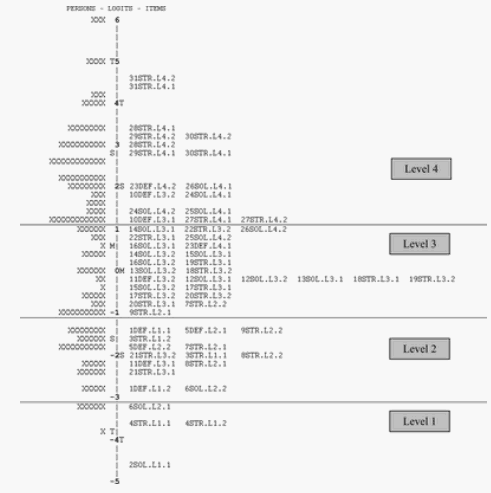I had heard the term "item map" being sometimes used to describe the representation of items and persons on the same continuum. I am not sure the origin of the term, nor of the idea. But I know that, for many years, Ben Wright had championed this approach to interpreting the results of measurement analyses, and also that he had made significant contributions to that approach, including enhancements and adaptations such as Kidmaps, fit maps, maps for polytomous items, etc. It seemed to me that, in fact, Ben had made his most significant contributions to measurement in the area of conceptualizing measures, and interpreting the results of measurement analyses, and that his central tool in doing so were these (many forms of) items maps. In addition, I knew of no one else who had made an equivalent contribution, especially not in terms of item mapping. Hence, I coined the term "Wright Map" in honor of Ben Wright and his very deep contributions to measurement.
This was about the end of 1999 and the beginning of 2000. After that, I used the term in my class (EDUC 274A at UC Berkeley) to get used to the sound of it, and, as I was drafting the text of my book Constructing Measures (Wilson, 2004), it became embedded in the text. The first time I used the term in a formal presentation was at a conference in Banff, Canada:
Wilson, M., & Draney, K. (2000, May). Standard Mapping: A technique for setting standards and maintaining them over time. Paper in an invited symposium: "Models and analyses for combining and calibrating items of different types over time" at the International Conference on Measurement and Multivariate Analysis, Banff, Canada.
As far as I know, the first time the term appeared in print was when that conference paper was published:
Wilson, M., & Draney, K. (2002). A technique for setting standards and maintaining them over time. In S. Nishisato, Y. Baba, H. Bozdogan, & K. Kanefugi (Eds.), Measurement and multivariate analysis (Proceedings of the International Conference on Measurement and Multivariate Analysis, Banff, Canada, May 12-14, 2000), pp 325-332. Tokyo: Springer-Verlag.
The following presentation is also interesting, as that is the first time Ben Wright was in the audience (he was very moved):
Wilson, M. (2001, October). On choosing a model for measuring. Invited paper at the International Conference on Objective Measurement 3, Chicago, Il.
This conference paper was later published as:
Wilson, M. (2003). On choosing a model for measuring. Methods of Psychological Research-Online, 8(3), 1-22. Download: www.dgps.de/fachgruppen/methoden/mpr-online/
(Reprinted in: Smith, E.V., and Smith, R.M. (Eds.) (2004). Introduction to Rasch Measurement. Maple Grove, MN: JAM Press.)
Some might be surprised that Ben didn't invent the term himself, as he was usually far from modest in most matters. But I believe he was indeed quite modest in formal matters, and was delighted to hear his name being used in this way.
Mark Wilson
University of California, Berkeley
... the most helpful Rasch-based research for mathematics educators [and others!] marries the rigorous measurement demands of the model with the crucial qualitative distinctions demanded by researchers in our field. This marriage is most obvious in the way in which Rasch measurement output is often displayed as variable maps, supported - rather than replaced - by tables. The item-person map, often called a Wright map in honour of Rasch measurement's most tireless advocate, Ben Wright, displays both persons (in terms of their ability) and items (in terms of their difficulty) spaced along a common (usually) vertical axis marked with a scale.
Rosemary Callingham and Trevor Bond (2006) Research in Mathematics Education and Rasch Measurement. Editorial in Mathematics Education Research Journal, 18, 2, 1-10

Wright Map from: Rittle-Johnson B., Matthew P.G., Taylor , R.S. McEldoon K.L. (2011) Assessing knowledge of mathematical equivalence: A construct-modeling approach. Journal of Educational Psychology, 103, 1, 85-104.
Some Notes on the Term: "Wright Map", Mark Wilson ... Rasch Measurement Transactions, 2011, 25:3, 1331
| Forum | Rasch Measurement Forum to discuss any Rasch-related topic |
Go to Top of Page
Go to index of all Rasch Measurement Transactions
AERA members: Join the Rasch Measurement SIG and receive the printed version of RMT
Some back issues of RMT are available as bound volumes
Subscribe to Journal of Applied Measurement
Go to Institute for Objective Measurement Home Page. The Rasch Measurement SIG (AERA) thanks the Institute for Objective Measurement for inviting the publication of Rasch Measurement Transactions on the Institute's website, www.rasch.org.
| Coming Rasch-related Events | |
|---|---|
| Jan. 16 - Feb. 13, 2025, Fri.-Fri. | On-line workshop: Rasch Measurement - Core Topics (E. Smith, Winsteps), www.statistics.com |
| Apr. 8 - Apr. 11, 2026, Wed.-Sat. | National Council for Measurement in Education - Los Angeles, CA, ncme.org/events/2026-annual-meeting |
| Apr. 8 - Apr. 12, 2026, Wed.-Sun. | American Educational Research Association - Los Angeles, CA, www.aera.net/AERA2026 |
| May. 15 - June 12, 2026, Fri.-Fri. | On-line workshop: Rasch Measurement - Core Topics (E. Smith, Winsteps), www.statistics.com |
| June 19 - July 25, 2026, Fri.-Sat. | On-line workshop: Rasch Measurement - Further Topics (E. Smith, Winsteps), www.statistics.com |
The URL of this page is www.rasch.org/rmt/rmt253b.htm
Website: www.rasch.org/rmt/contents.htm